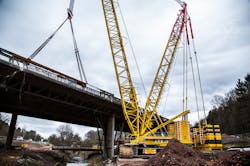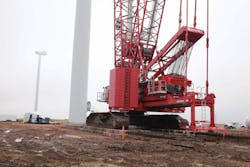The market for lattice boom crawler cranes is strong, thanks to more work in the energy and oil sectors, along with infrastructure projects such as bridge construction and repair.
“Since the second half of last year, through this year, and into next year, we see a fairly strong market,” says Harley Smith, P.E., global product director for Manitowoc. “Prior to that, it was slow. In general, you have energy, especially wind energy, now contributing, and the oil prices are starting to go up a little bit, which is usually an indicator of an upward trend. Refinery work, energy, petrochemical, and large infrastructure are your biggest drivers.”
Wind farms, in particular, are driving more demand.
“For new installations, the lattice boom cranes will be the product of choice,” Smith says. “If you’re just changing out blades, you can utilize a larger all-terrain crane, or two of them. But on larger projects or larger maintenance jobs, you’ll see a lot of lattice boom cranes in those applications.”
Lattice boom cranes may be configured a bit differently to tackle wind jobs.
“It depends on the variable terrain of the sites, and how effectively the machines can be assembled and travel along those sites,” Smith says. “Every year we see the wind projects with higher demands, either in higher heights or higher lifted loads. There are much longer boom lengths on wind farms, and in some applications you’ll see special jibs or attachments that provide boom clearance. With pieces that are big and long, the loads can be kind of obtuse at their lifting point, so the cranes need to provide more clearance to the boom or jib, which can drive the size of the machines larger when compared to other lifting applications.”
Crane makers have responded to the robust market with models that incorporate more technology. The differences in lattice boom cranes from 20 and even 10 years ago are major and have implications for both set- up and safety. “The electrical controllers used to drive the machines, the main CPUs, are larger and more comprehensive,” Smith says. “You’re able to find more utilization out of more robust packages.
“Plus, they function more collaboratively with the whole system—integrating limit switches to understand areas where you cannot go,” Smith says. “Those are some of the more fundamental engagement tools that are integrated into the operational controls and warnings that maybe in the past...were in manuals for the consideration of the operator. In some cases, they do serve the purpose as operator aids, and sometimes they prevent the product from getting itself into a more compromising situation.”
In-cab displays and the intuitiveness of the controls are also much improved.
“With every operating system, the intuition of it can help support the training and the interface between the user and the tool,” Smith says. “The Rated Capacity Limiter (RCL) now is pretty routine, but the RCL screens in terms of the crane set-ups and just the visual indications to make sure things are set up properly, those are becoming more enhanced as machines mature through technology.”
Smith says that lattice booms have followed the general progression of all products in becoming friendlier to use, with smaller size cranes receiving more electronic features and therefore more use.
“Every product class in some respects is starting to consume the product class above it at the lower end,” Smith says. “Every range of products has its space based on its unique benefits, and the larger models are growing up and taking some of the market of the products that were above them.”
Advancements in crane self-assembly
Self-assembly systems themselves are not new, but noteworthy innovations continue to speed crane set-ups and transport.
“In 1991, the Manitowoc M250 was a 300-ton crawler that could self assemble,” Smith says. “At that time, it was a larger-sized machine, but today a 300-ton is pretty typical and self erecting has become the industry norm, driven by a principle that some level of self erect is
a requirement.”
Liebherr’s LR 1800-1.0 has two features that stand out. With the “VarioTray,” after raising the lattice boom with the large derrick ballast, part of the ballast can be unbolted quickly and easily. Only a small proportion of the ballast is generally required for hoisting work with the boom in steep position. This avoids the stacking and unstacking of ballast slabs, Liebherr says.
A new type of ballasting system is used for the suspended ballast. A hydraulically adjustable folding frame allows the ballast radius to be adjusted to up to 23 meters. This means that a fixed guiding frame is no longer required for large radii.
The ballast consists of 10-metric-ton Liebherr standard slabs. It can be used universally on other Liebherr crawler crane models. The LR 1800-1.0 operates with a maximum of 230 metric tons of slewing platform ballast, 70 metric tons of central ballast, and up to 400 metric tons of derrick ballast.
For transport, the company has developed a new concept for its boom system. Three lattice sections are telescoped for transport. This principle has been designed and improved for the standard configuration with an 84-meter main boom and 84-meter luffing jib. The large lattice sections are at the bottom section of the main boom, the medium ones in the top section of the main boom, and in the bottom section of the luffing jib. The small lattice sections are installed in the upper section of the luffing jib. The standard length can be extended to the maximum length of the boom system of 102 meters for the main boom plus 102 meters for the luffing jib.
The basic machine is designed with a 3-meter transport width and a maximum transport weight of 45 metric tons. The weight of the crawler travel gear of 60 metric tons can be reduced to a transport weight of less than 45 metric tons by removing the tracks. The base plates have a standard width of 2 meters to keep the ground pressure as low as possible.
Terex has a system called “Split Tray” on its CC 3800-1, which recently aided a bridge job in Eppelborn, Germany, where space was tight.
“We had just about 20 meters available to us,” says René Perlich, head of large cranes for contractor Steil Kranarbeiten, Trier, Germany. Perlich’s technicians had to install the Superlift boom and mast piece by piece.
The assembly usually requires 36 meters.
The divisible Split Tray Superlift system frame proved to be advantageous in Eppelborn, since the radius of the heavy parts created some challenges due to limited space on the construction site. “We picked up the heavy loads with extremely wide radii of up to 36 meters and then placed them behind the crane with a reduced radius of about 14 meters,” Perlich says. “The use of the Split Tray saved a lot of time due to the simple uncoupling of unnecessary counterweight.” The assist crane was needed only after completing the lifts for stacking of the counterweights.
Crane telematics
As it has in earthmoving equipment, telematics is making its way into cranes.
One example is the Kobelco Remote Observation Satellite System, or KCross, which is standard on all G-2 Series models. It’s a proprietary system that allows remote monitoring of the unit from the owner’s desktop. The system was designed to be as user-friendly as possible, Kobelco says, providing daily, weekly, and monthly reports that the owner can print. This allows a look at all of the crane’s data in an easy-to-read format.
The owner can log on and click the daily report tab, and a one-page report will show the hours the unit worked, how much fuel was consumed, how many minutes the crane idled, how many minutes the main winch was used, how many minutes the crane travelled, what percentage of chart the crane lifted, and more.
For buyers, Manitowoc’s Smith says uptime, service, and support are the most important considerations.
“When you get to the larger sizes, parts availability and service capabilities become a really strong incentive [for buyers],” Smith says. “These machines are centerpieces on a lot of large projects, and these projects consume so much investment every day, whether it be people, or material coming in for the work. So everything is staged very specifically. If the machine is down, how quickly it gets back up and running is vitally important to the value of the customer and their customers as well.
“As you go down across all models, service is going to be a key indicator of how equipment managers understand their fleet,” Smith says. “The equipment managers, that world is so small, a lot of them know each other. Good news travels fast and bad news travels fast, so everyone has a good understanding of the successes and failures other companies have had with different pieces of equipment—the reliability for uptime is crucial regardless of size.”
Lattice boom cranes tend to last a long time,
Smith points out, reaching second, third, and fourth owners. He’s received calls on some models that are
50 years old.
“There’s a lot of resale in the category,” Smith says. “New cranes in large numbers go to rental houses, and a lot of owned cranes are 15- to 20-years old, and many last longer.”






